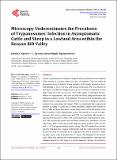Microscopy Underestimates the Prevalence of Trypanosomes’ Infection in Asymptomatic Cattle and Sheep in a Lowland Area within the Kenyan Rift Valley

View/
Publication Date
2019Author
Emmily C Ngetich, Ngeiywa Moses
Metadata
Show full item recordAbstract/
Animal trypanosomosis continues to impede animal production in sub-Saharan Africa mostly in locations where tsetse flies are endemic. This has ended up devastating many livelihoods where majority of the people depend on livestock farming as source of food and income generation. The true picture on prevalence and identity of trypanosome species is scanty or unknown in most areas where tsetse flies are present. This study sought to investigate the prevalence of trypanosomes’ infection in cattle and sheep using microscopy and polymerase chain reaction (PCR) methods. The use of PCR for detection and identification of trypanosomes has increased sensitivity of diagnostic method compared to conventional microscopy. Ninety asymptomatic free range grazed animals including 72 cattle and 18 sheep randomly sampled from farmers in Kerio Valley of Elgeyo-Marakwet County, Kenya were used in the present study. Blood samples (5 ml) obtained from each of the animals were used for trypanosomes’ detection by microscopy and PCR assay methods. Microscopy results showed that only 2 cattle (2.8%) were positive for trypanosomosis infection. The microscopy results for the sheep showed zero prevalence. On the other hand, PCR results reported 26 trypanosomosis positive cattle (36.1%) and 3 (16.7%) trypanosomosis positive sheep. The PCR method was further used for trypanosomes’ species identification and the results showed that the 26 infected cattle were positive for T. congolense (12) and T. brucei (14) while the three sheep were all positive for T. brucei. The findings of the present study show that microscopy underestimates trypanosomosis detection and therefore cannot be relied upon as a tool for diagnosis. Besides, the method is weak in reporting species differentiation in a case where the morphological differences have only minor details or where the species are very close morphologically. This study recommends routine use of molecular biology-based technique for trypanosomosis detection in the Kenyan Rift Valley lowland areas.
